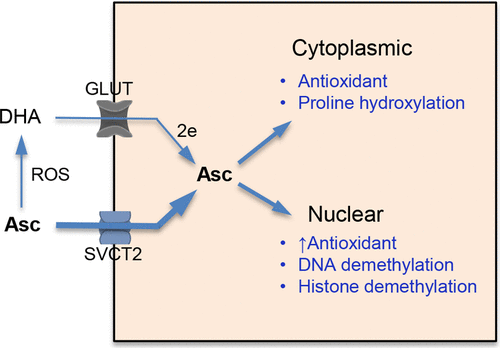当前位置:
X-MOL 学术
›
Chem. Res. Toxicol.
›
论文详情
Our official English website, www.x-mol.net, welcomes your
feedback! (Note: you will need to create a separate account there.)
Nuclear and Cytoplasmic Functions of Vitamin C
Chemical Research in Toxicology ( IF 3.7 ) Pub Date : 2020-10-01 , DOI: 10.1021/acs.chemrestox.0c00348 Anatoly Zhitkovich 1
Chemical Research in Toxicology ( IF 3.7 ) Pub Date : 2020-10-01 , DOI: 10.1021/acs.chemrestox.0c00348 Anatoly Zhitkovich 1
Affiliation

|
Vitamin C (ascorbic acid) is a water-soluble antioxidant and a cofactor for a large number of enzymes. It is present in all tissues and especially abundant in corneal epithelium, stem cells, and neurons. Although similar to thiols in its ability to react with many reactive oxygen species (ROS), ascorbate is much better (>100× faster) than glutathione at scavenging of primary ROS (superoxide radical and singlet oxygen). Ascorbate appears to be especially important for elimination of O2•– in the nucleus which contains little or no SOD activity. Cofactor functions of ascorbate involve the maintenance of activity of Fe(II)/2-oxoglutarate-dependent dioxygenases via reduction of Fe(III). The most prominent activity of ascorbate-dependent dioxygenases in the cytoplasm is hydroxylation of prolines in proteins involved in the formation of extracellular matrix and regulation of metabolism and hypoxia responses. In the nucleus, ascorbate is important for oxidative demethylation of 5-methylcytosine in DNA (by TET proteins) and removal of methyl groups from histone lysines (by JmjC demethylases). Differentiation and other cellular reprograming processes involving DNA demethylation are especially sensitive to ascorbate insufficiency. High doses of vitamin C alone or in combinations with drugs produced cancer-suppressive effects which involved redox, immune, and epigenetic mechanisms. Solutions to vitamin C deficiency in cultured cells are discussed to improve the physiological relevance of in vitro models. An abundance of vitamin C in rodents limits their ability to fully recapitulate human sensitivity to adverse health effects of malnutrition and xenobiotics, including neurotoxicity, lung injury, and intergenerational and other epigenetic effects.
中文翻译:

维生素 C 的核和细胞质功能
维生素 C(抗坏血酸)是一种水溶性抗氧化剂,也是许多酶的辅助因子。它存在于所有组织中,在角膜上皮、干细胞和神经元中尤其丰富。尽管在与许多活性氧 (ROS) 反应的能力方面与硫醇相似,但抗坏血酸在清除初级 ROS(超氧自由基和单线态氧)方面比谷胱甘肽要好得多(> 100 倍快)。抗坏血酸似乎对消除 O 2尤为重要•–在细胞核中含有很少或没有 SOD 活性。抗坏血酸的辅因子功能涉及通过还原 Fe(III) 来维持 Fe(II)/2-氧代戊二酸依赖性双加氧酶的活性。细胞质中抗坏血酸依赖性双加氧酶最突出的活性是参与细胞外基质形成和代谢和缺氧反应调节的蛋白质中脯氨酸的羟基化。在细胞核中,抗坏血酸对于 DNA 中 5-甲基胞嘧啶的氧化去甲基化(通过 TET 蛋白)和从组蛋白赖氨酸中去除甲基(通过 JmjC 去甲基化酶)很重要。涉及 DNA 去甲基化的分化和其他细胞重编程过程对抗坏血酸不足特别敏感。高剂量的维生素 C 单独或与药物联合使用会产生癌症抑制作用,这涉及氧化还原、免疫和表观遗传机制。讨论了培养细胞中维生素 C 缺乏症的解决方案,以改善其生理相关性。体外模型。啮齿动物中丰富的维生素 C 限制了它们完全概括人类对营养不良和外源性物质对健康的不利影响的敏感性的能力,包括神经毒性、肺损伤以及代际和其他表观遗传影响。
更新日期:2020-10-21
中文翻译:

维生素 C 的核和细胞质功能
维生素 C(抗坏血酸)是一种水溶性抗氧化剂,也是许多酶的辅助因子。它存在于所有组织中,在角膜上皮、干细胞和神经元中尤其丰富。尽管在与许多活性氧 (ROS) 反应的能力方面与硫醇相似,但抗坏血酸在清除初级 ROS(超氧自由基和单线态氧)方面比谷胱甘肽要好得多(> 100 倍快)。抗坏血酸似乎对消除 O 2尤为重要•–在细胞核中含有很少或没有 SOD 活性。抗坏血酸的辅因子功能涉及通过还原 Fe(III) 来维持 Fe(II)/2-氧代戊二酸依赖性双加氧酶的活性。细胞质中抗坏血酸依赖性双加氧酶最突出的活性是参与细胞外基质形成和代谢和缺氧反应调节的蛋白质中脯氨酸的羟基化。在细胞核中,抗坏血酸对于 DNA 中 5-甲基胞嘧啶的氧化去甲基化(通过 TET 蛋白)和从组蛋白赖氨酸中去除甲基(通过 JmjC 去甲基化酶)很重要。涉及 DNA 去甲基化的分化和其他细胞重编程过程对抗坏血酸不足特别敏感。高剂量的维生素 C 单独或与药物联合使用会产生癌症抑制作用,这涉及氧化还原、免疫和表观遗传机制。讨论了培养细胞中维生素 C 缺乏症的解决方案,以改善其生理相关性。体外模型。啮齿动物中丰富的维生素 C 限制了它们完全概括人类对营养不良和外源性物质对健康的不利影响的敏感性的能力,包括神经毒性、肺损伤以及代际和其他表观遗传影响。










































 京公网安备 11010802027423号
京公网安备 11010802027423号